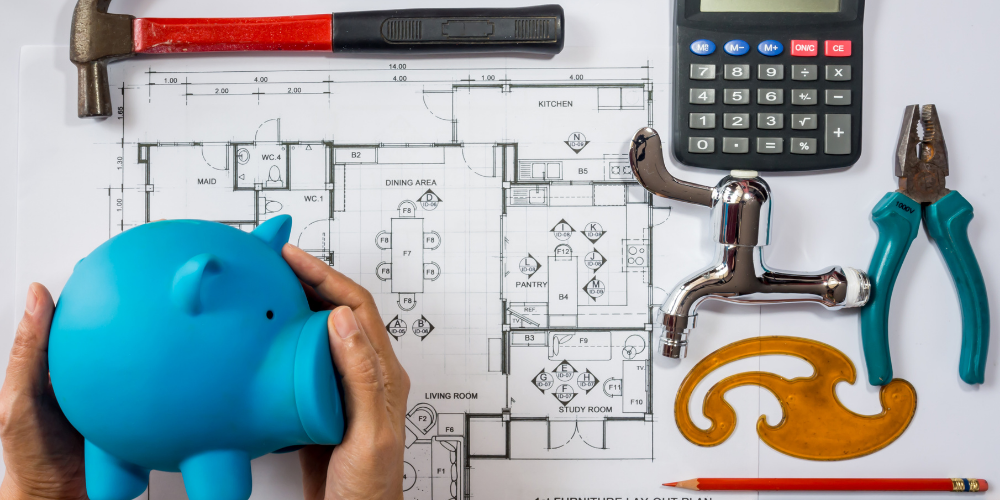Prioritizing Home Improvement Projects on a Budget
- 11 Apr, 2022
- •
- 1 Comment
In a perfect world, home remodels would happen overnight. You’d wake up one morning to find your home transformed without having to deal with the hassle of planning, budgeting, or living through construction. However, we don’t live in a perfect world. And, if you’re like most homeowners, you probably have a never-ending list of home improvement projects that you’d like to get to but don’t have the time or money for. Feels overwhelming, right?
 We’ve got your back. The Louisville Handyman + Remodeling team has been helping clients who may be feeling overwhelmed by house renovations for 20 years, with the customer reviews to show for it. We’re happy to share our knowledge with you, so keep reading for four steps to prioritize your renovation to-do list and budget. We’ll tell you what order to do a home renovation on a budget, what things to expect when you’re remodeling, and how to get the most bang for your buck!
We’ve got your back. The Louisville Handyman + Remodeling team has been helping clients who may be feeling overwhelmed by house renovations for 20 years, with the customer reviews to show for it. We’re happy to share our knowledge with you, so keep reading for four steps to prioritize your renovation to-do list and budget. We’ll tell you what order to do a home renovation on a budget, what things to expect when you’re remodeling, and how to get the most bang for your buck!
1. Assessing Your Needs
Knowing what you need is an essential ingredient to planning any home improvement. So before you do anything else, take a moment to tour your house and think about your daily routine. Is there a frustrating backup in the bathroom every morning because too many people are trying to use it all at once? Then maybe you’re due for a bathroom remodel or addition. Is your kitchen overflowing with pots and pans? Try adding a pantry or expanding your cabinetry. While you’re at it, identify functional problems — such as doors that don’t close or drawers that collide — and check for any structural issues (it’s advisable to contact a professional for help with this). Finally, ask yourself what areas of the house you spend the most time in and whether you want to dedicate a home improvement project to make them a more enjoyable space.
2. Knowing the Financials
Next, it’s time to take a look at the financials. Start by getting local cost estimates for the remodeling projects you’re considering. For a place to start, check out Remodeling Magazine’s 2021 Cost vs Value Report, a localized guide that gives you estimates for various types and qualities of home improvements.
Then take a look at your finances to see how much you can spend on home improvements now and estimate how much you’ll be able to spend in the future. If you’re considering bigger home improvements, such as an addition or multi-room renovation, you can also take into consideration financing options. Take your time here because this information is crucial in the next two steps.
3. Consideration & Prioritization
By now you should know what you can afford and what you’re trying to accomplish. Next, you need to figure out how you’re going to get it done. This can be a daunting part of the process. You might be wondering where to start when updating a house or how to prioritize home improvement necessities. And if you are, know the hardest part is not getting overwhelmed. There are a lot of moving parts, but you can start to sort through them based on your priorities and several important considerations we recommend you take into account:
- Structural or Safety-Related Repairs. These repairs are essential to the wellness of your home and family and should be among your highest priorities. Plus, catching structural repairs early on, before the damage is too severe, can save you lots.
- Finances. Remember when we said you’d need to have a solid assessment of your financials for the next part? Well, here we are. Take a look at what you can afford now and see which of your top priorities you can tackle with those funds. And don’t be discouraged if you have a bunch of priorities you won’t be able to get to for a while. In the next step, we’ll go over making a plan for future projects.
- Life Disruption. The larger the home improvement, the more likely it is to cause a disruption in your life. Consider what time of the year is best suited for such a disturbance and what level of disruption you’re willing to tolerate at this point in your life.
- Return on Investment. ROI should be one of your main considerations when it comes to how you prioritize home projects. The Cost vs Value report also includes information on the ROI for local remodeling projects, but generally speaking, kitchen remodels, exterior improvements — such as window, garage door, or siding replacements —, outdoor living area additions, and bathroom remodels tend to yield high ROIs. However, ROI is influenced by locale, so it’s a good idea to talk to a real estate agent about which home improvements will help you get the most money back for your investment.
With these considerations, as well as your home improvement needs (from step one), in mind, you can decide which projects to focus on first and which to save for later. But more on that in the next step.
4. Making a Plan
This is the part where you put together all the information you’ve aggregated in the last three steps and make a plan. A lot of people want a clean and clear home renovation “order of work” or “remodel order of necessity.” But the truth is, there is no set order of remodeling a house. You have to decide the sequencing of your home improvement projects based on your finances, needs, and all the other factors we’ve discussed in this article.
But, if you did your work in the first steps, making a plan shouldn’t be too difficult. You should already see certain priorities standing out, now you simply have to align them with your finances and schedule. We encourage you to make a five-year home improvement plan, especially if you have a lot of home improvement projects on your to-do list. A long-term plan allows you to do a project here and there while saving up money in between.
Need Help With Your Home Improvements?
Even armed with the most thorough research and industry-tested advice, completing home improvement projects can be difficult and sometimes you’ll need a little help. At Louisville Handyman and Remodeling, our services range from kitchen, bathroom, and whole-home remodeling to gutter cleaning, painting, plumbing, and more. Our experienced team will make things easy while providing quality results and a finished product you’ll love!








